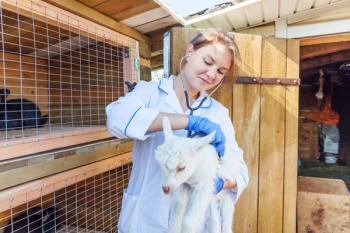
Immunology for dummies-a painless review of basic concepts (Proceedings)
The immune system has two arms of defense, nonspecific and specific. As with the immune system in total, there are many elements of the nonspecific arm of the immune response. These have in common their lack of strict recognition of foreign material and absence of memory.
The immune system has two arms of defense, nonspecific and specific. As with the immune system in total, there are many elements of the nonspecific arm of the immune response. These have in common their lack of strict recognition of foreign material and absence of memory. The nonspecific arm is also referred to as innate immunity, as it is present at birth unlike specific acquired immunity, which develops after birth and is also known as adaptive immunity. The innate response is the first line of defense against infectious disease, and if effective, may completely eliminate the agent before the specific adaptive immune response is called upon. It also interacts with the adaptive immune response, aiding its activation and modulating the response.
The simplest components of the innate response to understand are the anatomic and physiologic barriers. These include the skin and mucous membranes, as well as physical parameters like temperature, pH, and oxygen levels. These barriers are comprised not only of the cells at the surface, but soluble components as well, such as enzymes, antimicrobial peptides, and cytokines.
More complex, but still nonspecific in terms of antigen recognition are the phagocytic and cytotoxic cells, as well as various soluble components. Cellular components include neutrophils, eosinophils, basophils, mast cells, and natural killer lymphocytes. The first four types are of granulocyte lineage, and possess cytosolic granules filled with enzymes and microbicidal substances; in addition, neutrophils and eosinophils are phagocytic. Natural killer cells, though from the lymphocyte lineage, lack antigen-specific receptors on their surface, and are important mediators of cell-mediated immunity. Distinct from these cells are the monocytes/macrophages, and dendritic cells. Monocytes are phagocytic cells circulating in the blood, while macrophage is the term for these cells in tissue. Dendritic cells are distinct phagocytic cells found in tissue and lymphoid tissue. All three of these cell types, in addition to phagocytosis and destruction of invading microbes, are critical to the specific immune response. In particular, dendritic cells are integral to an effective and appropriate immune response.
The specific immune response involves lymphocytes, the only cells which possess specificity, diversity of recognition, and memory. The lymphocytes can be divided into subgroups based on cell surface markers, as well as function. The B lymphocytes are the antibody factories of the immune response (secretors are termed plasma cells), and also function as antigen presenting cells for the T helper lymphocytes. This latter group can be considered the orchestrators of the specific response, and carry out this mission through secretion of various cytokines, soluble messengers of the immune response. This group can be subdivided further based on the direction in which the T helper cell pushes the response, and are designated by subtype numbers of descriptions, i.e. TH1, TH2, TH17, and T regulatory lymphocytes. A group of T lymphocytes distinct from T helper lymphocytes is the cytotoxic T lymphocytes, the hired assassins. They specifically target cells that have been altered, such as by microbial invasion, and induce apoptosis in the target cell, in essence removing the "microbial factory".
While the innate immune response is not specific in terms of antigen recognition, many components do have pattern recognition. Microbial agents contain unique molecules not found in higher organisms, referred to as pathogen associated molecular patterns (PAMP's). The receptors for these molecules, referred to as pathogen recognition receptors (PRRs), may be soluble in plasma, present on cell surfaces, or expressed within the cellular cytoplasm. Recognition and binding of microbes by receptors present on cell surfaces lead to activation of intracellular signaling pathways, altering gene expression, and facilitating elimination of the pathogen. The phagocytic cells, including macrophages, dendritic cells, and neutrophils, express a variety of these PRRs, allowing recognition of pathogens, and enhancing phagocytosis and destruction of the pathogen. Dendritic cells in particular are critical to the adaptive immune response, presenting antigen to cytotoxic T lymphocytes as well as T helpers.
Lymphocytes are divided into distinct types based on phenotype and function, but share some common properties. They achieve their tremendous diversity of recognition by rearrangement of the gene segments encoding their antigen receptors during development. They maintain their tolerance to self through a rigid selection process that occurs upon completion of this gene rearrangement and the resultant commitment to a specific antigen. Lymphocyte types vary in the precise mechanism of antigen recognition, as well as effector functions. B lymphocytes develop in the bone marrow, and express immunoglobulins on their surface that function in antigen recognition and binding. They recognize soluble or extracellular epitopes that are conformation dependent. Antibody binding to the target mediates a number of effector functions, discussed below. The biologic function is determined in part by the antibody isotype or class, which is determined by the heavy chain structure. Unlike B lymphocytes, T lymphocytes leave the bone marrow and mature in the thymus. Like B lymphocytes, the T cell receptor diversity is generated by gene rearrangement. Unlike B lymphocytes, they recognize antigen only when it is bound to self major histocompatibility complex molecules. T lymphocytes are further divided into two lineages based on differing functions and cell surface markers. Cytotoxic T lymphocytes (TC) expressing CD8 cell marker recognize antigen displayed on MHC I (expressed on all cells), and function to induce apoptosis in the cell displaying this antigen. T helper lymphocytes (TH) display a CD4 membrane glycoprotein and function in modulation of the immune response via secreted molecules (cytokines) and cell surface molecule expression. They recognize antigen displayed on MHC II expressed on antigen presenting cells, including macrophages and dendritic cells as well as B lymphocytes.
Antigen encounter combined with appropriate intercellular signals leads to activation, proliferation, and differentiation of the responding lymphocytes. Once antigen is recognized by the lymphocyte, and the costimulatory signal is received, the lymphocyte proliferates, producing more cells with the same antigenic specificity. These cells differentiate into effector cells to deal with the current infection, or memory cells for future infections with the same pathogen. The latter cells are long-lived, and require only the antigen encounter for activation – the costimulatory signal is not needed. Thus, memory cells are more easily activated. The humoral response, constituted by antibodies mediates protection against extracellular pathogens. The cell-mediated response, which is made up of not only cytotoxic T lymphocytes, but neutrophils, macrophages, and natural killer cells, combats intracellular pathogens by eliminating the cell that harbors them. The T helper lymphocytes are critical to both humoral and cell-mediated functions
The inflammatory and immune response is initiated by tissue damage or infection which is detected by white blood cell surveillance. Cellular damage leads to release of vasoactive and chemotactic factors, which in turn leads to increased vascular permeability and vasodilation at the site. This allows leakage of soluble mediators at the site of injury/infection. The vascular endothelial cells in the region begin to express cellular adhesion molecules, facilitating extravasation of white blood cells at the site of inflammation. Invading pathogens are initially detected by white blood cells of the innate response using TLRs. Once activated by pathogen detection, some of these leukocytes will release mediators that function in recruitment of effector cells. Among these, chemokines are important chemoattractants of additional leukocytes. Other chemoattractants include complement breakdown products and microbial peptides. In response, leukocytes are able to migrate to the scene following the trail of chemotactic factors. Neutrophils are often first on the scene, but other granulocytes, as well as tissue macrophages and dendritic cells are involved. Phagocytosis and microbial destruction follow the arrival of these cells to the site. The invading pathogens and tissue damage may be dealt with by the innate response. In most cases, however, the antigen-specific response mediated by lymphocytes follows, and requires the innate immunity. The interaction of APCs and lymphocytes promote lymphocyte activation, proliferation, and differentiation into effector and memory cells within the lymphoid tissue. The nonspecific and specific immunity thus collaborate to eliminate the pathogen.
References
Kindt TJ, Goldsby RA, Osborne BA. In: Immunology. New York: W. H. Freeman and Company; 2007.
Takeuchi, O, Akira S. Innate immunity to virus infection. Immunological Reviews 2009: 227: 75-86.
Lee KH, Iwasaki A. Innate control of adaptive immunity: Dendritic cells and beyond. Seminars in Immunology 2007: 19: 48–55.
Savina A, Amigorena S. Phagocytosis and antigen presentation in dendritic cells. Immunological Reviews 2007: 219: 143–156.
Sojka DK, Huang YH, Fowell DJ. Mechanisms of regulatory T-cell suppression – a diverse arsenal for a moving target. Immunology 2008: 124: 13–22.
Kaiko GE, Horvat JC, Beagley KW, et al. Immunological decision-making: how does the immune system decide to mount a helper T-cell response? Immunology 2007: 123: 326–338.
Saalmuller, A. New understanding of immunological mechanisms. Veterinary Microbiology 2006: 117: 32–38.
Newsletter
From exam room tips to practice management insights, get trusted veterinary news delivered straight to your inbox—subscribe to dvm360.




